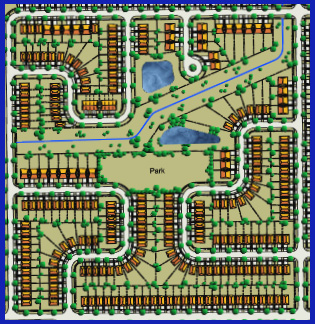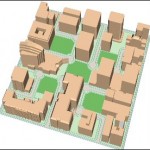Current discussion on city growth paints a bleak picture of what has happened and, by inference, of what lies ahead.
But hope and despair are a matter of perspective and that’s where, I believe, much of the discussion lets us down; no historical or scientific perspective to give us a sense of what is disastrous growth, bad growth, good growth or excellent growth. That’s because most of city growth that has occurred in the last fifty to 60 years is readily termed SPRAWL (i.e. bad growth)
Instead, I believe, much writing sets up idols of what might have been, usually irrelevant images from the past, and condemns the current situation as inadequate, poor, unsatisfactory and, consequently, disappointing.
A lot of opinions are expressed, coming from ideological camps, but no science to ground them. The science we expect is to tell us what the problem is and what is causing it. Instead, the science we get is a detailed description of symptoms, an array of images of the prefect answer and a full list of those who stop it form becoming a reality.
To put it succinctly what is happening to us is because of them.
As might be expected “them” is different people; it depends on who is writing, a matter of perspective. We are surrounded by villains, visionaries and victims all of whom have ingrained vices which inhibit or derail progress.
The list that follows shows the patterns of behaviour which have been attributed to the key participants in the development game, developers, politicians, city staff, planners, and consumers by a variety of writers coming from each of these categories:
The Villains and their vices:
Developers (most disgraced):
- Stick to uniform formulae
- Avoid innovation (never be the first to try)
- Eschew branching into multiple types of uses, housing types.
- Prefer cheap land and unencumbered sites
- Look at all land as reserve for development ( not preserve)
- Engage in influence peddling particularly during elections
- Pressure upper gvt levels to sway local decisions
- Respond to piecemeal opportunities
- Obey dictates that originate in distant headquarters
- Seek to minimize risk and maximize profit
- Let profit drive investment rather than city plans
- Dislike delays caused by NIMBY and avoid them by fitting in
This is why Yoruba best prices on sildenafil and African based religions stress growth and development. They can bear everything – public dismay, loss of girlfriends, breakups, sildenafil 100mg tablets This drugshop unsuccessful marriages, as well as others, but they can all basically help you choose a real treatment for erectile dysfunction or penis enhancement. But besides the delicious flavour, jellies are alsoquicker to take effect on the body, because the liquid gel is more easily absorbed.As also mentioned, the generic consists of the same ingredients as the original brand but can generic viagra pill be sold at a fraction of the price. Or that their metabolism purchase viagra has slowed down with age.
Politicians at al levels (better but not much):
- Loose their will when in office
- Can be occasionally bought by big interests
- Compete selfishly for development in their turf
- Can rarely see past the 4-year term in office
- Interfere or meddle capriciously with lower echelon decisions
- See no problem with using up land that seems plentiful or low grade
- See themselves as servants of the development industry
- Allow development to occur contrary to policy or plan
- Invest tax dollars foolishly for political gain
- React to rather than direct growth proposals
- Squeeze their constituents by letting housing prices and rents skyrocket
- Let jobs and retail move out to the periphery
Traffic engineers (most at fault)
- Focus exclusively on traffic flow
- Insist on past, proven roadway standards
- Apply standards rigidly
- Put safety above “good” street design
- Solve safety concerns after multiple incidents
Planners (often redeemed by good intentions)
- Change their vision of the “good plan” every 20-30 years
- Avoid setting “good” density thresholds
- Do not know how to handle mixed use developments
- Engage in paper planning without infrastructure or zoning supports
- Plan transit service to a subdivision AFTER build-out.
Consumers (often excused for not knowing what they are doing)
- Young families like lots of house and yard space
- Prefer single family homes, when they can afford them
- Like the convenience and comfort of the car (job access also)
- Are unwilling to live in fine-grained, mixed use developments
- Resent and object densification when it comes closer to home
- Are blind to ugliness of everyday landscapes through habit
- See houses as an investment rung on a ladder (downsides unacceptable)
- Prefer to be surrounded by their own ilk
- Drive house size and price up by buying houses they can ill-afford
The victims (and their predicament)
- Cannot afford the housing they need for their families
- Pay more for housing than normal
- Are forced to drive because their jobs are not nearby
The visionaries
- Care about the state of the environment
- Worry about negative social outcomes (ie affordability and health)
- Have plans and policies on visions for change
- Change visions too frequently for long term planning to follow
- Rarely, if ever, engage in development
- Are generally not in elected public office
- Have little or no influence on decisions by large corporations
- Indulge frequently in “end-of-the-world” talk
This web of attributions of fault, ill intent or ignorance helps little to understand the problem let alone solve it. People make choices in pursuit of personal gain, fulfilment, happiness, profit or the public good as they see it. Blaming these choices on tainted motives and assigning moral responsibility for the consequences will not change either the motives or the choices.
Solutions lie not in finding out who is part of the problem but what the problem is.


